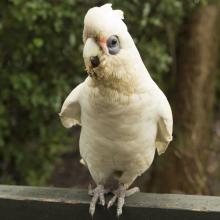
Bare-eyed Cockatoos roost in trees overnight, then fly out in search of food like seeds, flowers, and other parts of plants. They are known to adapt their feeding habits to the changing seasons, finding the available food sources in different areas. This flexibility helps them thrive even in regions with fluctuating vegetation patterns.
These highly sociable birds often form large mixed-species flocks, where they exhibit social behavior and have the ability to learn behaviors from fellow flock members.. A flock of Bare-eyed Cockatoos can be heard for kilometers due to their extremely loud screeching calls.
When it comes to nesting, Bare-eyed Cockatoos exhibit a preference for tree hollows. They usually select large, mature trees with suitable cavities. Once a pair has formed, they work together to prepare the nest cavity for egg-laying. The female lays a clutch of one to three eggs, with two being the most common. The eggs are white and oval-shaped. Incubation lasts 28-30 days, and young cockatoos fledge 70-80 days after hatching.
Bare-eyed Cockatoos have a very large range across Australia. Their population is increaing as they are tolerant of disturbed habitat and human-inhabited areas.
